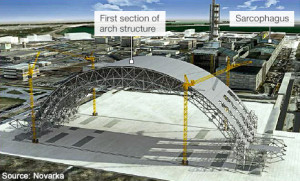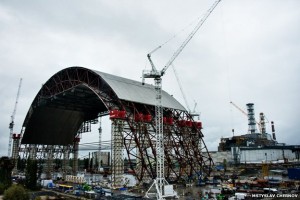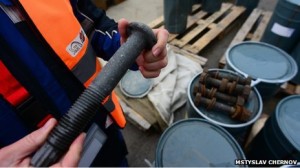Chernobyl’s Arch: Sealing Off a Radioactive Sarcophagus
ENERGY, 2 Dec 2013
27 Nov 2013 – Work began in recent days to remove, bit by bit, the giant chimney protruding from the Chernobyl nuclear power station. It’s one small part of a mammoth engineering project, now nearing completion, designed to slash the risk of another major release of radioactivity.
Massive and glittering in the weak winter sunshine, a half-built arch looms over Chernobyl’s decaying industrial landscape of cooling towers and power lines.
One of the biggest engineering projects in history, it has been likened to a gigantic metal igloo, built to seal off hundreds of tons of nuclear fuel and dust buried inside reactor number four, which in 1986 blew up and burned for 10 days.
Everything about the project is epic: the size, the 1.5bn euro (£1.2bn) cost, the technical problems of working on a radioactive building site.
At 110m (360ft) tall, the structure could house the Statue of Liberty, and at 257m (843ft) wide, there would be room for a football pitch. There are acres of metal panels in the roof, to seal off the reactor and the dangerous mess inside. The whole lot will be held together by 680,000 heavy bolts.
With these gigantic dimensions the arch would be difficult to build anywhere, but it is being assembled in one of Europe’s more remote corners, a site surrounded by forest and marsh in northern Ukraine, far from the factories of Western Europe where its component parts are made. This autumn, as the project reached the half-way point, it was more than a decade behind schedule, although engineers believe work will now go more quickly and it could be finished in 2015.
“Nothing like this has ever been attempted before,” says Don Kelly, 57, a nuclear industry veteran from Washington State, as he walks under the arch. He works with foreign specialists from 24 nations, as well as hundreds of Ukrainian workers. Young French technicians, who monitor radiation, work alongside Ukrainian veterans of the 1986 disaster, former Soviet engineers who risked their lives battling to put the fires out after the reactor exploded, sending a cloud of radioactivity across Europe.
Grinning with enthusiasm as he stares up at the roof, Mr Kelly points out Turkish workers in harnesses far overhead. “For anyone in the nuclear business, this is the place you want to be: the biggest, most exciting project in the world right now,” he says.
Every stage of the project has been a step into the unknown. Nobody has ever had to make a wrecked nuclear reactor safe before. Just preparing the site where the arch is being assembled required the removal of hundreds of tons of radioactive topsoil, then laying concrete foundations 8m (26ft) deep.
The reactor building itself, badly damaged in the 1986 explosion and fire, is still far too radioactive for people to work there assembling the arch above it.
Instead the arch has had to be put together a few hundred metres away, at a safer distance from the reactor’s intense radiation. Half of it is ready, and when the other half is finished, the two parts will be clamped together. Then, as nervous engineers look on, 29,000 tons of metal will slide along specially laid tracks, until the reactor is covered and sealed off.

The arch is being assembled in two halves in an area about 300m to the west of the sarcophagus, to protect workers from high levels of radiation. The project is due to be completed in 2015.
At present, it is contained by a shelter of concrete and metal panels called the sarcophagus, built in the months after the accident. It was supposed to have been replaced in 2006, and although it has been shored up, it is now rusting and in danger of collapse. Last February there was a radiation alert when part of the turbine hall roof next to the reactor collapsed. The site was evacuated, although nobody suffered harmful effects and work soon resumed.
Everyone hopes the arch will be completed before there is a major collapse. If this were to happen now, it would send a plume of radioactive dust into the sky, scattering radiation across a large area. It’s one reason Ukrainians worry about the repeated delays to the project.
The area under the arch is now safe enough for people to work unprotected, although dosimeters and breathing equipment must be carried at all times. But just a couple of hundred metres away, workers must wear white suits and hats, and breathe through masks.
This month, one of the trickiest operations in the whole project began, the removal of the old reactor chimney, which must be got out of the way before the arch can slide into place.
Work has started removing sections weighing up to 55 tons each. They must be cut off with a plasma cutter by teams of two workers and removed by crane – a nerve-racking process. If a crane fails, or an operator miscalculates, and a section falls into the reactor, this too could release a new cloud of radioactive dust into the atmosphere.
Anyone working on the chimney must also be carefully monitored. All staff working on the arch have an annual allowance of exposure to radiation. Once it has been used up, they are sent to work offsite. Around the chimney, an entire year’s allowance will be used up in a few hours.
Engineers say the radioactive environment is why work has been so slow. “It’s not dangerous, it’s just very, very difficult,” says Philippe Casse, 61, the site manager. “You have to organise everything to avoid the risk to people. But it is worth doing. I’m not just here to make a living, I’m here to make Chernobyl safe.”
More from the Magazine
Much of the 30km exclusion zone around the Chernobyl nuclear plant is pine forest, and some of it so badly contaminated that a forest fire could create a devastating radioactive smoke cloud.
The cost of the project is being borne by some 40 countries, and the work is being done by Western corporations assisted by Ukrainian companies. Nearly three decades after the accident, the radioactive mess in Chernobyl remains a grave threat to the health of Ukrainians.
Eventually, when the arch seals off the reactor, the plan is for giant cranes to lift out the remains of the reactor and what’s left of the fuel, which melted and flowed like lava into chambers beneath it. But there are fears the cranes would quickly become so radioactive they could not be maintained, and would gradually stop working. There is also still no suitable nuclear waste dump in the country.
Philippe Casse acknowledges that getting rid of all this highly radioactive material will be far more difficult than building the arch.
“Disposal will be an even bigger project,” he says.
“There is no money at the moment.
“It could be done in 50 years’ time. Perhaps there will be the technology to solve the problem then.”
Radioactive dose limits at Chernobyl
The annual radioactive dose limit is 20 millisieverts (mSv).
Some parts of the Chernobyl site are more radioactive than others, so the time that workers are permitted to spend in any one place varies.
Three separate ways of reaching the annual dose limit would be to spend:
- 50,000 hours at the on-site office
- 2,000 hours in control room Unit 4
- 12 minutes above the sarcophagus roof
Correction 29/11/13: This story originally said the arch was being funded by the G8 countries, but many other countries have also contributed funds.
DISCLAIMER: The statements, views and opinions expressed in pieces republished here are solely those of the authors and do not necessarily represent those of TMS. In accordance with title 17 U.S.C. section 107, this material is distributed without profit to those who have expressed a prior interest in receiving the included information for research and educational purposes. TMS has no affiliation whatsoever with the originator of this article nor is TMS endorsed or sponsored by the originator. “GO TO ORIGINAL” links are provided as a convenience to our readers and allow for verification of authenticity. However, as originating pages are often updated by their originating host sites, the versions posted may not match the versions our readers view when clicking the “GO TO ORIGINAL” links. This site contains copyrighted material the use of which has not always been specifically authorized by the copyright owner. We are making such material available in our efforts to advance understanding of environmental, political, human rights, economic, democracy, scientific, and social justice issues, etc. We believe this constitutes a ‘fair use’ of any such copyrighted material as provided for in section 107 of the US Copyright Law. In accordance with Title 17 U.S.C. Section 107, the material on this site is distributed without profit to those who have expressed a prior interest in receiving the included information for research and educational purposes. For more information go to: http://www.law.cornell.edu/uscode/17/107.shtml. If you wish to use copyrighted material from this site for purposes of your own that go beyond ‘fair use’, you must obtain permission from the copyright owner.

